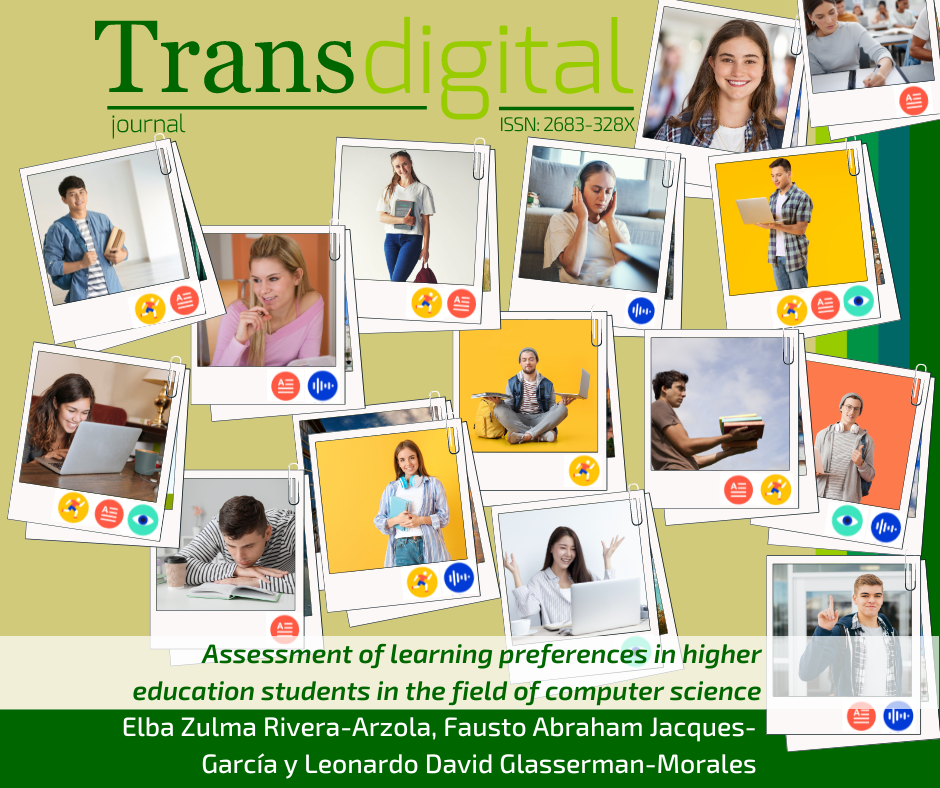Assessment of learning preferences in higher education students in the field of computer science
DOI:
https://doi.org/10.56162/transdigital187Keywords:
learning preferences, VARK, multimodal preference, computer science students, higher educationAbstract
When discussing learning processes, one way of approaching it is to consider the knowledge of cognitive, affective, and physiological traits, the way of organizing information, or the preferences that are easier to learn. The aim of this study was to identify the learning preferences of higher education students in computing to select instructional strategies that lead to better use. A non-experimental quantitative approach was followed using the VARK learning preferences instrument, with the intention of determining sensory modality preferences in information processing. The sample was non-probabilistic and consisted of 31 participants. The results indicate that 58% of the students have more than one learning preference, with 19% of them presenting a Type 1 and Type 2 multimodal preference, with all four preferences equally represented.
References
Alkooheji, L., & Al-Hattami, A. (2018). Learning Style Preferences among College Students. International Education Studies, 11(10), 50. https://doi.org/10.5539/ies.v11n10p50
Alonso, C., Gallego, D., y Honey, P. (2007). Los estilos de aprendizaje. Mensajero.
Arenas, E. P. (2017). Estrategias de estilos de aprendizaje de estudiantes: Proceso de validación. Alteridad, 12(2), 224. https://doi.org/10.17163/alt.v12n2.2017.08
Emami, M. R., Bazzocchi, M. C. F., & Hakima, H. (2020). Engineering design pedagogy: a performance analysis. International Journal of Technology and Design Education, 30, 553-585. https://doi.org/10.1007/s10798-019-09515-7
Fleming, N. D. (2022a). Introduction to VARK. VARK Learn Ltd. https://vark-learn.com/introduction-to-vark/
Fleming, N. D. (2022b). The VARK Modalities. VARK Learn Ltd. https://vark-learn.com/introduction-to-vark/the-vark-modalities/
Fleming, N. D. (2022c). The VARK Questionnaire Version 8.01. VARK Learn Ltd. https://vark-learn.com/el-cuestionario-vark/
Fleming, N. D. (2022d). Using VARK on the Research: Analyzing the VARK Results. VARK Learn Ltd. https://vark-learn.com/using-vark/using-vark-in-research/
Gómez, E., Jaimes, J. y Severiche, C. (2017). Estilos de aprendizaje en universitarios, modalidad de educación a distancia. Revista Virtual Universidad Católica del Norte, 50, 383-393. http://revistavirtual.ucn.edu.co/index.php/RevistaUCN/article/view/829/1347
Hasibuan, M. S., Nugroho, L., & Santosa, P. (2018). Prediction Learning Style Based on prior Knowledge for Personalized Learning. 4th International Conference on Science and Technology (ICST), Yogyakarta, Indonesia, 1-5, https://doi.org/ 10.1109/ICSTC.2018.8528572
Huang, R., Spector, J. M., & Yang, J. (2019). Introduction to Educational Technology. En Educational Technology: A Primer for the 21st Century (pp. 3–31). https://doi.org/10.1007/978-981-13-6643-7_1
Leite, W. L., Svinicki, M. & Shi, Y. (2010). Attempted Validation of the Scores of the VARK: Learning Styles Inventory With Multitrait-Multimethod Confirmatory Factor Analysis Models. Educational and Psychological Measurement. 70, 323-339.
Lozano, A. (2021). ¿Qué sabemos de los estilos de aprendizaje? En A. Lozano, C.S. Tapia, & R.I. Pizá (Eds.), Docencia y aprendizaje en ambientes convencionales y no convencionales. Retos y realidades con impacto educativo. CLAVE. https://www.itson.mx/publicaciones/Documents/ciencias-sociales/Docencia%20y%20aprendizaje%20en%20ambientes%20convencionales%20y%20no%20convencionales%20__%2018-10.21.pdf
Meyer, A. J., Stomski, N. J., Innes, S. I., & Armson, A. J. (2016). VARK learning preferences and mobile anatomy software application use in pre-clinical chiropractic students. Anatomical Sciences Education, 9(3), 247–254. https://doi.org/10.1002/ase.1555
Núñez, F., Hernández, R., Mariano, V. y Redondo, A. (2013). Identificación de estilos de aprendizaje en alumnos universitarios de computación de la Huasteca Hidalguense mediante técnicas de minería de datos. Ciencia Huasteca Boletín Científico de la Escuela Superior de Huejutla, 1(2), 121-141. https://doi.org/10.29057/esh.v1i2.1018
Porras-Mucha, C., Carhuas, I., Quispe, M. y Ríos, C. (2021). Estilos de aprendizaje en estudiantes universitarios: una revisión descriptiva de la literatura. Desafíos, 12(2); 109-16. https://doi.org/10.37711/desafios.2021.12.2.345
Sarmiento, A. (2017). Diseño y selección de instrumentos para determinar los diferentes estilos de aprendizaje de los estudiantes de bachillerato de la UAC y su relación con el uso de las TIC. Revista Iberoamericana de Producción Académica y Gestión Educativa, 4(8).
Timisina, P. P., Tschewang, U., Tshering, N., Sherab, R., Dawa, K., Dorji, T., & Tashi, P. (2021). Preferred Learning Style of Students of Nangkor Central School, Bhutan. Journal of the International Society for Teacher Education, 25(1), 35–47. https://doi.org/10.26522/jiste.v25i1.3659
UNESCO (2017). Herramientas de formación para el Desarrollo Curricular: Aprendizaje Personalizado. Organización de las Naciones Unidas para la Educación, la Ciencia y la Cultura. http://www.ibe.unesco.org/es

Downloads
Autor de correspondencia
El autor de correspodencia se identifica con el siguiente símbolo: *Published
How to Cite
License
Copyright (c) 2023 Elba Zulma Rivera-Arzola, Fausto Abraham Jacques-García, Leonardo David Glasserman-Morales

This work is licensed under a Creative Commons Attribution 4.0 International License.
All articles in Transdigital are licensed under a Creative Commons Attribution 4.0 International License. Authors hold the copyright and retain publishing rights without restrictions.









